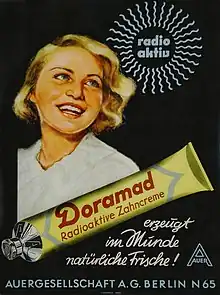Doramad Radioactive Toothpaste

Doramad Radioactive Toothpaste (Doramad Radioaktive Zahncreme) was a brand of toothpaste produced in Germany by Auergesellschaft of Berlin from the 1920s through World War II.[1] It was known for containing thorium, a radioactive metal, and is an example of radioactive quackery.
Development
The toothpaste was slightly radioactive because it contained small amounts of thorium obtained from monazite sands.[1][2] Auergesellschaft used thorium and rare-earth elements in making industrial products including mantles for gas lanterns; the toothpaste was produced as a byproduct.[1] Its radioactive content was promoted as imparting health benefits, including antibacterial action and a contribution to strengthening the "defenses of teeth and gums".[1][2]
According to the manufacturer's marketing materials, it was said to work due to the biological properties of the thorium increasing the circulation of the blood in the gums, destroying germs, and increasing the "life force" in the tissues of the mouth.[3]
Effect
The agent promised radiantly white teeth and bacterial extraction due to the ionizing radiation of the contained radioactive substances. She counted at the time as a milestone of technical achievements and was touted as a “miracle remedy”. Consequential damage caused by ionizing radiation were as good as not known. Only after the atomic bomb abjects on Hiroshima and Nagasaki were recognized the potential effects of ionizing radiation; thus, the toothpaste was invalid.
The packaging was specified with the specification:
“Special biological healing effects by radium rays. A thousand times medically prescribed and recommended.”
On the back of the toothpaste tube was the following:
"What does Doramad do? Through their radioactive radiation, it increases the defenses of tooth u. Gums. The cells are charged with new life energy, which is inhibited bacteria in their destructive effectiveness. Therefore, the exquisite prevention and healing effect in gum diseases. Polish the enamel on the most gentlest white and shiny. Prevents tartar approach. Foamily, tastes novel, pleasant, mild u. Refreshing. Extensive in use."
World War II
During the German military administration in occupied France during World War II, a group of German scientists stole all the thorium they could while in occupied France. The Alsos Mission thought they were using the heavy elements for the refinement of uranium to be used in an atomic bomb. However, after Allied agents captured and investigated a German chemical company's representative, it was revealed that the scientists were not seeking to develop an atomic bomb at all; rather, they were attempting to make thorium toothpaste.
According to physicist Samuel Goudsmit in a 1947 issue of Time, the German chemical company's officials had realized that, at the end of the war, they would no longer be able to make money producing wartime equipment such as gas masks or carbons for searchlights, and they decided cosmetic products would be their best option for future sales. One of the company's officials already had a patent for thorium toothpaste (likely unrelated to Doramad) and, influenced by marketing for Pepsodent "irium" toothpaste in the United States, the company sought to gain a monopoly on all the thorium they could find in order to produce as much thorium toothpaste as they could after the war, which led to the company's scientists stealing all of France's thorium. The identity and fate of the chemical company, the fate of the stolen thorium, and whether or not the thorium toothpaste was actually produced after the war is unknown.[4]
See also
References
- 1 2 3 4 Eugen Merzbacher (April 2012). "Readers' Forum: Radioactive toothpaste and reversed helicity". Physics Today. 65 (4): 10. doi:10.1063/PT.3.1500.
- 1 2 "Doramad Radioactive Toothpaste (ca. 1940-1945)". Health Physics Historical Instrumentation Museum Collection. Oak Ridge Associated Universities. Archived from the original on 2021-10-06. Retrieved 2021-10-06.
Doramad radioactive toothpaste was produced during World War II by Auergesellschaft of Berlin.
- ↑ Santos, Lucy Jane (2020). Half Lives The Unlikely History of Radium. London: Icon Books Ltd. ISBN 1-78578-608-3. OCLC 1158229829.
- ↑ Goudsmit, Samuel (October 20, 1947). "Nazis' Atomic Secrets". TIME. p. 123–134.
External links